- Clone
- W18197C (See other available formats)
- Regulatory Status
- RUO
- Other Names
- Transcription Factor EB
- Isotype
- Rat IgG2a, κ
- Ave. Rating
- Submit a Review
- Product Citations
- publications
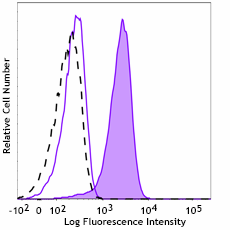
-

Daudi cells (positive control, filled histogram) and Jurkat cells (low expression control, open histogram) were fixed and permeabilized using True-Nuclear™ Transcription Factor Buffer Set (Cat No. 424401) and intracellularly stained with PE anti-TFEB (clone W18197C), or PE rat IgG2a, κ isotype control (open histogram, dashed line) (representative histogram for both cell lines) (Cat No. 400508).
| Cat # | Size | Price | Quantity Check Availability | Save | ||
|---|---|---|---|---|---|---|
| 936103 | 25 tests | 156€ | ||||
| 936104 | 100 tests | 306€ | ||||
The autophagy-lysosomal pathway is required for the quality control degradation of proteins and other macromolecules. The transcription factor EB (TFEB) plays a critical role in inducing expression of genes involved in autophagy and lysosomal biogenesis. The subcellular localization and activity of TFEB are regulated by mechanistic target of rapamycin (mTOR)-mediated phosphorylation. Under nutrient-replete conditions, mTORC1 phosphorylates TFEB promoting its cytosolic retention by 14-3-3 proteins and nuclear export through CRM1. Under nutrient deprivation, TFEB phosphorylation decreases, promoting its nuclear import and transactivation function. TFEB is frequently dysregulated in cancer, and is also involved in the clearance of intracellular pathogenic targets in a variety of diseases, such as Parkinson's and Alzheimer's, suggesting that novel therapeutic strategies could be based on the modulation of TFEB activity.
Product DetailsProduct Details
- Verified Reactivity
- Human
- Antibody Type
- Monoclonal
- Host Species
- Rat
- Immunogen
- Partial recombinant human TFEB protein
- Formulation
- Phosphate-buffered solution, pH 7.2, containing 0.09% sodium azide and BSA (origin USA)
- Preparation
- The antibody was purified by affinity chromatography and conjugated with PE under optimal conditions.
- Concentration
- Lot-specific (to obtain lot-specific concentration and expiration, please enter the lot number in our Certificate of Analysis online tool.)
- Storage & Handling
- The antibody solution should be stored undiluted between 2°C and 8°C, and protected from prolonged exposure to light. Do not freeze.
- Application
-
ICFC - Quality tested
- Recommended Usage
-
Each lot of this antibody is quality control tested by intracellular immunofluorescent staining with flow cytometric analysis. For flow cytometric staining, the suggested use of this reagent is 5 µL per million cells in 100 µL staining volume or 5 µL per 100 µL of whole blood. It is recommended that the reagent be titrated for optimal performance for each application.
- Excitation Laser
-
Blue Laser (488 nm)
Green Laser (532 nm)/Yellow-Green Laser (561 nm)
- Application Notes
-
When TFEB is phosphorylated, a molecular weight increase may be observed by western blot (Martina JA, et al. 2013. J Cell Biol. 200:475).
Differences in the observed molecular weight across cell lines and tissues may be attributed to differences in basal TFEB phosphorylation in these samples. - RRID
-
AB_2936766 (BioLegend Cat. No. 936103)
AB_2936766 (BioLegend Cat. No. 936104)
Antigen Details
- Structure
- TFEB is a 476 amino acid protein with a predicted molecular weight of 53 kD.
- Distribution
-
Nucleo-cytoplasmic/Ubiquitously expressed
- Function
- Transcription Factor required for inducing expression of genes involved in autophagy and lysosomal biogenesis.
- Biology Area
- Cell Biology, Transcription Factors
- Antigen References
-
- Napolitano G, et al. 2018. Nat Commun. 9:3312.
- Peña-Llopis S, et al. 2011. EMBO J. 30:3242.
- David R, et al. 2011. Nat Rev Mol Cell Biol. 12:404.
- Settembre C, et al. 2011. Science. 332:1429.
- Gene ID
- 7942 View all products for this Gene ID
- UniProt
- View information about TFEB on UniProt.org
Related FAQs
- What type of PE do you use in your conjugates?
- We use R-PE in our conjugates.
Other Formats
View All TFEB Reagents Request Custom Conjugation| Description | Clone | Applications |
|---|---|---|
| Purified anti-TFEB | W18197C | WB,IP,ICFC,IHC-P |
| PE anti-TFEB | W18197C | ICFC |
| Alexa Fluor® 647 anti-TFEB | W18197C | ICFC |
Compare Data Across All Formats
This data display is provided for general comparisons between formats.
Your actual data may vary due to variations in samples, target cells, instruments and their settings, staining conditions, and other factors.
If you need assistance with selecting the best format contact our expert technical support team.
-
Purified anti-TFEB
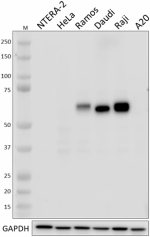
Whole cell extracts (15 µg protein) from NTERA-2 and HeLa (r... 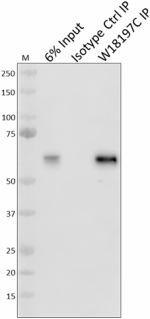
Whole cell extracts (250 µg total protein) prepared from Raj... 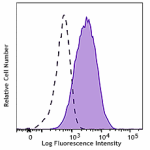
Daudi cells (filled histogram, positive control) and Jurkat ... 
IHC staining of Purified Anti-TFEB (clone W18197C) on formal... -
PE anti-TFEB
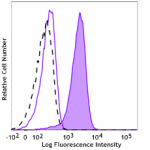
Daudi cells (positive control, filled histogram) and Jurkat ... -
Alexa Fluor® 647 anti-TFEB
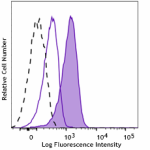
Daudi cells (positive control, filled histogram) and Jurkat ...
 Login / Register
Login / Register 












Follow Us